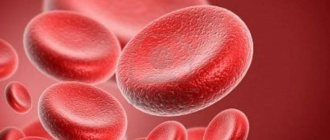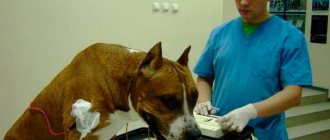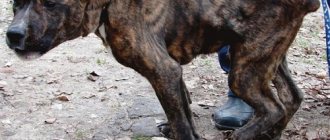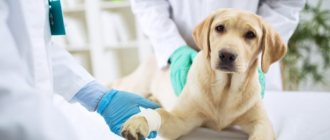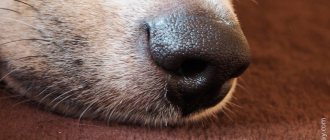Anemia manifests itself in different ways in dogs. The disease requires complex treatment; it occurs if the level of hemoglobin in the blood decreases. Hemoglobin is part of erythrocytes - red blood cells. Red blood cells are needed for the body to work smoothly. Blood cells deliver oxygen to organs and tissues. The production of red blood cells takes place in the bone marrow structures, from these parts they enter the blood.
Red blood cells live 50-60 days, they can be damaged and detached from the blood. The destruction of red blood cells occurs in the spleen. If the body loses a lot of red blood cells, anemia occurs. Anemia is a rare disease and the causes of its development are associated with numerous factors. An animal suffers from anemia if the body is deficient in vitamins and microelements, in particular iron. Iron is found in red blood cells, a microelement essential for any living organism.
What is hemoglobin?
If a veterinarian says that a dog has high hemoglobin, what does this mean? This question is asked by absolutely all pet owners who have little understanding of medical terms and everything related to the health of their pets.
What is the doctor talking about? About the number of red blood cells in the animal’s blood and their condition. Hemoglobin is a special protein that contains iron and is an integral part of the red blood cell. This component of the blood composition forms relationships with oxygen and carbon oxides.
Video about anemia in dogs
The Greek word “anemia” consists of two parts: “no” and “blood”, which in life looks like a violation of the composition of the blood, or more precisely, a decrease in the number of red blood cells and hemoglobin per unit volume, that is, anemia. Erythrocytes, or red blood cells, are saturated with oxygen in the lungs and carry it to all organs.
Hemoglobin, an iron-containing blood protein, maintains stable metabolism and gas exchange in the body. Changes in the composition of a dog's blood lead to cellular oxygen starvation.
You can notice the appearance of anemia in dogs by the following signs:
- Pale mucous membrane of the oral cavity (cheeks, lips, palate). It can be light pink or interspersed with white spots.
- Lethargy of the pet. The dog is reluctant to go for walks, eats without appetite (sometimes completely refuses food), is unable to withstand physical activity, and most often lies down.
- Shortness of breath, rapid breathing.
- Increased thirst.
- Fever.
- Vomiting and diarrhea.
- An increase in the amount of urine or a brown coloration.
One dog will exhibit several of the above symptoms of anemia at the same time, but not all at once
. The combination of certain signs of a blood disease indicates to specialists the possible causes of its occurrence:
Why is it dangerous to increase its level?
Any abnormalities associated with hemoglobin levels lead to disturbances in oxygen transport function. An excess of this protein, which is no longer able to retain red blood cells, has a toxic effect when it enters the blood plasma. That is, it simply poisons the body. Also, when excess iron-containing proteins are released, the red blood cell cell ruptures, and accordingly, it dies. In response, the body begins to intensify the production of these components, that is, the volume of red blood cells in the blood increases sharply, while the balance of elements is disrupted.
An excess of free hemoglobin leads to the development of the following pathologies:
- blockage of channels in the kidneys;
- necrosis (death) of tissues;
- acute failure of internal organs.
As a rule, renal failure occurs, but pathogenic dysfunction can also develop in other organs.
An increase in the number of red blood cells or their swelling causes lung problems, cardiac problems and many other pathologies.
What is the normal level of hemoglobin in dogs and what to do if it is high or low?
They are prescribed only by a veterinarian after a complete examination of the animal. Because the main task is not to reduce hemoglobin, but to cure the underlying disease. A special diet is also necessary to limit the intake of foods that increase hemoglobin:
- beef liver,
- meat,
- red fruits and berries.
And, on the contrary, in your daily diet you need to include foods that lower hemoglobin: cereals, vegetables and green fruits, salads from fresh herbs. Sometimes hemoglobin by a procedure such as erythrophoresis.
Anemia ( Anemia ) from the Greek an - negative particle and haima - blood - a clinical and hematological syndrome associated with a decrease in the number of red blood cells and hemoglobin per unit volume of blood.
Hemoglobin performs the function of delivering oxygen to the tissues and cells of the animal’s body.
Red blood cells are produced in the bone marrow and from there enter the blood, where they live for about 2 months. As red blood cells age or become damaged, they are filtered from the bloodstream, destroyed in the spleen, and removed from the circulatory system. The iron found in red blood cells is recycled to create new red blood cells.
Anemia in dogs, as a rule, is secondary and the basis of anemia is a variety of pathological processes. Sometimes anemic syndrome is the main one in the clinical picture and determines the prognosis of the disease; in other cases, anemia can be expressed very moderately.
During the diagnostic process, veterinary specialists must determine the pathogenetic mechanism of anemic syndrome (bleeding, deficiency of iron, vitamin B12, hemolysis, etc.) with subsequent identification of the disease underlying the anemia.
Etiology. Anemia in dogs can be caused by:
- Internal and external bleeding as a result of injuries sustained by the dog.
- Bleeding in the gastrointestinal tract as a result of disease or severe inflammation.
- Infectious diseases (infectious hepatitis, leptospirosis, piroplasmosis), cancer, diseases of the liver, kidneys, spleen, bladder leading to blood clotting disorders.
- Hereditary - hemolytic autoimmune anemia.
- Poisoning with chemicals (poisoning with lead compounds, poisoning with zinc compounds) and drugs.
- Lack of vitamin B12, iron, copper, folic acid in the diet (can be both congenital and acquired).
- In puppies, anemia often occurs due to parasitism by fleas and worms.
Anemia affects dogs of all breeds and ages. Blood mass in anemia can be normal, reduced, or even increased due to compensatory replenishment of the lack of fluid with tissue fluid. Simultaneously with quantitative changes during anemia, qualitative changes in the formed elements of blood occur in the body of a sick dog, which are caused by a reduced hemoglobin content in each erythrocyte and are accompanied by functional insufficiency of the erythrocyte system.
Pathogenesis. With anemia in the body of a sick dog due to impaired blood supply to organs and tissues, oxidative processes are disrupted, oxygen starvation (hypoxia) and hypoxemia develop in the tissues. In the blood of a sick dog, under-oxidized metabolic products and waste products accumulate, which must be excreted from the body in the urine.
What is the normal hemoglobin level?
Veterinarians diagnose increased hemoglobin in dogs if the levels exceed 120-180 units. This is the normal level of red blood cells in the blood of an adult animal.
For puppies, of course, the norm will be different. The level of red blood cells in puppies should be at the level of 74-180 units. Of course, the older the animal, the higher the indicator should be. If a dog’s red blood cell level is at 74-80 units at 9-11 months, then this already indicates a deviation from the norm.
Establishing diagnosis
The main diagnostic method for determining anemia is a clinical blood test. Based on this study alone, it is already possible to identify anemia. It is more difficult to understand what caused the pathology, so the veterinarian may prescribe:
- Analysis of urine;
- stool occult blood test;
- X-ray;
- Ultrasound of the abdominal organs;
- tests for genetic diseases;
- endoscopy;
- tests for the presence of parasites in the blood.
Despite a wide range of studies, sometimes it is not possible to determine the exact cause of anemia in a dog.
What symptoms indicate an increase in the number of red blood cells?
High hemoglobin is much more difficult to recognize than low hemoglobin. There are no obvious symptoms for this condition.
Owners should be alert to the following:
- bright color of mucous membranes;
- breathing problems;
- cardiac arrhythmia;
- constant thirst.
A high level of hemoglobin is especially noticeable if the pet cuts itself while walking. The blood of dogs with an excess of red blood cells is very thick, it resembles jelly. That is, blood will neither flow nor ooze from the wound, it will hang in drops.
Symptoms
In mild cases of anemia, it is difficult to notice the symptoms of the disease, and a blood test is often required to determine the percentage of red blood cells and confirm the diagnosis. Anemia develops against the background of another disease, so even if symptoms are present, it is difficult to determine the true cause on your own.
Due to the low level of hemoglobin, oxygen starvation of cells occurs, as a result of which symptoms of anemia such as lethargy and decreased activity appear.
The primary sign of anemia is pallor of the oral mucosa, in particular the gums, which become pale pink or almost white. Pale gums and flaccidity are good reasons for a blood test.
Other symptoms of anemia are rapid pulse, difficulty breathing, decreased appetite, and with hemolytic anemia, jaundice appears.
How is hemoglobin level determined?
During a full examination of animals in veterinary clinics, a blood test is also taken. From dogs whose condition does not cause any concern, as a rule, blood is taken only for a general or, as it is more often called, clinical analysis. When deciphering the received data, the number of red blood cells is revealed, that is, the level of hemoglobin in the blood is determined.
If the animal’s condition causes any concern or suspicion to the veterinarian, then a biochemical study is also carried out. It does not reflect the level of hemoglobin, but gives an idea of the development of various pathological conditions caused by an increase in red blood cells or which are the cause of this imbalance of blood components.
Prevention
There are no universal preventive measures, because the causes of anemia are different and it is impossible to protect your pet from all dangers. But you can reduce the risk of developing anemia if you provide the animal with proper care, including proper feeding, regular examination, visiting a veterinarian, vaccination, and thereby protect it from the development of diseases that contribute to anemia.
When treating diseases, it is important to frequently do blood tests in order to identify the body’s negative reaction to the drugs administered, and in case of blood loss, a well-designed treatment plan is important.
Similar articles:
- Why does a dog's fur turn red?
- Shortness of breath in dogs
- Frostbite in a dog
- Chills in dogs
- Runny nose in dogs
- Fleas on dogs
What does a clinical general analysis reveal? How is it sold?
Of course, clinical analysis reveals not only low or high hemoglobin in dogs. This blood test allows veterinarians to get a complete, holistic picture of the animal's health.
The analysis includes the following parameters:
- hematocrit;
- hemoglobin level;
- color indicator;
- erythrocyte sedimentation rate and number;
- leukocytes and platelets.
Taking the test will require compliance with a special regime, which the doctor will definitely warn you about. Its essence boils down to the fact that the animal should not be fed before donating blood.
Biological material is collected from a vein. As a rule, a couple of milliliters of blood is enough for the study. The material taken for analysis is placed in a test tube with an anticoagulant that prevents the coagulation process.
Increased hemoglobin in dogs: causes, symptoms, treatment, diet
Increased hemoglobin in dogs, like decreased hemoglobin, is not an independent disease. But such a condition can cause the development of diseases or be their direct consequence. Therefore, an increase in hemoglobin levels cannot be ignored. It is imperative to find out why this happened, and, of course, bring the indicators back to normal or cure the disease that led to an increase in hemoglobin.
And of course, you need to imagine what it is, how it is determined and what is required to adjust its level.
Why does hemoglobin increase?
If a dog has increased hemoglobin, the reasons for this phenomenon may be associated with the presence of serious diseases or pathologies, as well as with any incidents, events in the life of the animal or with its diet.
As a rule, hemoglobin levels increase for the following reasons:
- poisoning of the body;
- dehydration;
- staying in rarefied air, that is, at a height, for example, on the roof of a skyscraper or in the mountains, in the basket of a balloon;
- excessive physical activity;
- specific nutrition;
- blood thickening due to pathogenic processes or due to hereditary predisposition.
Correctly determining the reason why the level of red blood cells is rising is very important. After all, it depends on her how to bring the hemoglobin indicator into line with the norm.
Causes of high or low hemoglobin in dogs
For example, an increase in hemoglobin levels indicates blood thickening, dehydration, excessive physical activity, and exposure to high altitudes. A decrease in hemoglobin leads to an ailment such as anemia. The dog looks lethargic, is reluctant to go for a walk, small puppies are slowly gaining weight.
Low or high hemoglobin in a dog is not a disease in itself, but a sign of some serious problems in the body.
Therefore, before thinking about how to increase or decrease it, you need to establish the causes of problems in the pet’s body.
Low hemoglobin levels can be caused by:
- lack of iron in the blood,
- vitamin deficiency,
- chronic diseases of the stomach, kidneys and liver,
- a growing tumor or blood loss even from blood-sucking parasites.
High hemoglobin can result from dog poisoning and subsequent dehydration, as well as very serious disorders in the body.
How to increase low hemoglobin in a dog?
You can restore hemoglobin levels by establishing proper nutrition for your dog.
It is necessary to introduce foods high in iron into your dog's diet. These should be scalded with boiling water before serving to the animal: But too many of these products should also not be on the dog’s menu. It is also worth giving your pet apples and hard-boiled eggs. And a children's hematogen will be a wonderful treat for him. If the hemoglobin level is critically low, it is necessary to use special medications prescribed by the veterinarian.
How to lower hemoglobin?
High hemoglobin is reduced with the help of special drugs that thin the blood.
What to do after a test that reveals an increase in hemoglobin?
If a veterinarian has detected increased hemoglobin in a dog, what should be done in this case? Of course, the doctor will prescribe a number of additional studies necessary in order to exclude the presence of internal diseases or, conversely, to identify them. If any pathology is detected, it should be treated, and then the hemoglobin levels will return to normal.
However, there are a number of general recommendations that must be followed regardless of the reason why the level of red blood cells has increased and, accordingly, hemoglobin has increased. Veterinarians usually explain in detail to the animal’s owners what and how they should do. At the same time, doctors are guided by the condition of a particular animal, so their advice cannot be avoided.
As for the recommendations common to all animals, then, of course, first of all it is necessary to exclude from the diet foods that increase hemoglobin. In addition, it is necessary to reduce the level of physical activity, for example, replace bicycle rides, during which the animal runs alongside, with calm and leisurely walks along park alleys or forest paths. It is also important to eliminate dehydration, this is especially true for dogs experiencing excessive stress and eating dry food.
What is the normal level of hemoglobin in dogs and what to do if it is high or low?
Thanks to the body's adaptive reactions (reflex increase in cardiac activity, respiration, the supply of red blood cells from blood depots, activation of hematopoiesis), gas exchange and oxidative processes are maintained at a sufficient level even with significant anemia in dogs. At the same time, with severe anemia, even a small load on the dog causes its heart to increase in speed, shortness of breath and other pathological phenomena appear. With severe anemia in a dog, the central nervous system is primarily affected, as a result of which the dog may faint.
In the chronic course of anemia in a dog, dystrophic changes occur in the parenchymal organs (fatty degeneration of the heart muscle, liver, kidneys) to the point that sometimes minor hemorrhages are observed in the serous and mucous membranes.
Clinical picture. Depending on the degree of saturation of red blood cells with hemoglobin (color indicator), veterinary specialists distinguish between normo-, hypo- and hyperchromic anemia in dogs. In normochromic anemia, the hemoglobin content in erythrocytes is within the physiological norm (the blood color index is close to one). With hypochromic anemia, red blood cells with a low hemoglobin content appear in the blood. At the same time, the decrease in hemoglobin content is more pronounced than the decrease in the number of red blood cells. The color index is less than one. All hypochromic anemias are iron deficiency. Hyperchromic anemia is characterized by a sharp decrease in the number of red blood cells and an increase in the content of hemoglobin in them. Anisocytosis is observed in the dog's blood, as well as normablastosis and poicolocytosis.
During a clinical examination of a dog with anemia, a veterinarian notes lethargy, depression, decreased activity, visible mucous membranes are pale, pinkish and white, and bleeding of the mucous membranes (gums) is noted. The pulse is frequent upon palpation, the heartbeat is rapid, murmurs are heard on auscultation of the heart, and as a result of a sharp drop in blood pressure, the dog may collapse. A sick dog often refuses food and has frequent, labored breathing. We record fever, thirst, and the presence of blood in the stool.
The diagnosis of anemia in dogs is made on the basis of the clinic, the results of laboratory tests of blood and urine. The blood is examined for coagulation, the laboratory reveals a decrease in the number of red blood cells, their structure, and red blood cell anomalies. A biochemical study of the bone marrow is performed. If internal bleeding is suspected, a veterinarian will perform laparocentesis (puncture of the abdominal cavity with a special needle and removal of a small amount of abdominal fluid). When conducting a comprehensive diagnosis of anemia in veterinary clinics, an x-ray and ultrasound of the abdominal cavity are performed. If there is a suspicion of a tumor, ulcer, etc., which can cause anemia in the dog, an endoscopy is performed. Special tests to determine in the blood - mycoplasmas, leptospira, babesia, etc. If, during an examination of a dog with anemia, the veterinarian suspects an oncological disease, a chest x-ray is performed.
The prognosis for anemia depends on the cause that caused the anemia and the general condition of the dog’s body. With timely diagnosis of anemia and satisfactory general condition of the sick dog, the prognosis is favorable. If anemia was a consequence of poisoning with pesticides (poisoning with zinc compounds), leukemia, autoimmune diseases, it is often unfavorable.
Treatment. Treatment of anemia in dogs is directly dependent on the cause that led the dog to anemia.
If a dog has anemia, veterinary specialists in veterinary clinics use:
- Intravenous infusions, which are aimed at increasing the volume of blood in the dog’s circulatory system.
- Transfusion of blood components (erythrocyte mass, platelets, whole blood mass) is carried out.
- Bone marrow transplantation is performed.
- If the dog has an additional infection, we administer a course of antibiotic therapy.
- A course of treatment with vitamin K1 (phylloquinone or phytomenadione), which normalizes blood clotting processes in the dog’s body.
- For anemia caused by blood parasite diseases (pyroplasmosis, leptospirosis), anti-blood parasite agents are used.
- The use of drugs that contain elements useful for the process of hematopoiesis - iron, phosphates, potassium (for hemolytic anemia, as well as for liver damage in dogs, the use of drugs containing iron is contraindicated).
- If anemia in a dog occurs as a result of poisoning with poisons or metal salts, it is necessary to use glucocorticoids, corticosteroids and other drugs depending on the cause of intoxication.
- The necessary therapeutic measures are carried out aimed at treating certain symptoms caused by anemia in the body. We are conducting a course of vitamin therapy.
- In case of severe internal and external bleeding, emergency surgery is resorted to.
How does eating dry food affect hemoglobin levels?
As a rule, most animal owners associate foods that raise hemoglobin with “normal food.” However, how many dogs eat liver, brains, liver, meat, lungs, etc.? How often in a modern city can you find a dog breeder who cooks porridge for an animal? As a rule, now even canteen and restaurant workers feed their pets with ready-made formulas. It's very simple and convenient. Large dogs usually eat dry food, while small dogs buy canned food.
And paradoxically, it is ready-made food that tops the list of those products that cause an increase in the level of red blood cells in the blood. Canned food does not have such an effect, but dry mixtures inevitably lead to an increase in hemoglobin levels.
Why is this happening? Because a distinctive feature of such foods is a large amount of protein in the composition, and, of course, they have specific absorption. When food enters the stomach, it must swell, and this requires water. As a rule, the vast majority of dog breeders feed their animals before a walk.
That is, the dog is exposed to physical stress while dry food swells in the stomach, which takes fluid from the body. That is why the animals do not miss a single puddle on the street, greedily lapping up this water, despite the menacing cries of their owners. And this is repeated daily. The logical result is an increase in hemoglobin with concomitant blood thickening and dehydration.
Evaluation of the result - Clinical blood test
It is characterized by a decrease in the body's endurance (tolerance of physical and mental stress), increased fatigue, weakness, reduced immunity, frequent ailments, a tendency to colds, pale skin, and palpitations.7. How to choose the right hematogen among the abundance of offers? The basis of all types of hematogen is albumin, and any product in this series is an additional source of iron. However, one of the conditions for the body to successfully absorb iron from foods and medicines is sufficient consumption of ascorbic acid. In addition, for normal absorption and use in hematopoiesis, in addition to vitamin C, B vitamins and folic acid are necessary. Accordingly, a product with an expanded list of micronutrients may be preferable. Also, when choosing, it makes sense to pay attention to the composition of excipients and calorie content. A product with a lower calorie content is preferable for people on a diet.8. Is it true that hematogen thickens the blood? No. Hematogen does not contain components that have a similar effect. A similar physiological effect can occur with severe degrees of dehydration and taking hormonal drugs.9. Does Hematogen really contain dried bovine blood? The main biologically active component of the FERROHEMATOGEN®-PHARMSTANDARD dietary supplement is black food albumin. Albumin is a substance obtained from the industrial processing of cattle blood. Differs in the content of proteins with high nutritional value, iron and other minerals, vitamins and carbohydrates.10. At what age and for what indications can Hematogen be given to a child? According to the package insert, dietary supplements can be taken by a child from 4 years of age if there is a risk of iron deficiency. It is recommended to consult a pediatrician before use.11. Is it worth restricting a child from hematogen if he loves him? Yes, of course, it is worth it. Hematogen is not candy, it is an additional source of nutrients, the consumption of which is regulated by the Norms of Physiological Needs. Excessive consumption of micro- and macronutrients can provoke metabolic disorders.12. Is it true that hematogen makes you fat? Gaining body weight largely depends on the caloric content of your diet. If you are concerned about exceeding the calorie content of your daily diet, you just need to take into account the calorie content of the dietary supplement you are taking: The calorie content of the daily dosage of “HEMATOGEN CHILDREN” for adults (50 g) is 203.5 kcal; daily dosage for children (25 g) – 101.8 kcal. The calorie content of the daily dosage of "FERROGEMATOGEN®-PHARMSTANDARD" for adults (50 g) is 188 kcal; daily dosage for children (25 g) – 94 kcal.13. Is it really safe to eat Hematogen on an empty stomach in order to suppress hunger if it is not possible to eat normally? According to the package insert, dietary supplements should be taken orally with meals. Such recommendations are aimed at preventing the possible development of dyspeptic reactions due to individual sensitivity or irritation of the gastric mucosa.14. Is it worth taking Hematogen during or after menstruation to restore lost blood? Since menstruation is accompanied by the loss of certain amounts of blood and, accordingly, iron, an additional source of iron, vitamins B6 and C, folic acid and copper will be required by the body to restore the balance of micronutrients. 15. Does hematogen cause allergies? Individual intolerance or allergic reactions in individuals can occur to any of the components of the product, similar to the many components of food products that cause individual atypical reactions. If symptoms of hypersensitivity to the components of the drug appear, you should stop using it.
source
What foods increase hemoglobin? What should you not give to your dog?
Accordingly, the basis of dietary nutrition is the exclusion of dry food while hemoglobin returns to normal. Of course, in the future it will be necessary to adjust its use.
But in addition to dry food, it is necessary to eliminate from the animal’s diet:
- offal;
- meat and liver;
- liver and blood sausages;
- red vegetables, berries and fruits.
In no case should you give the animal vitamin complexes containing iron during this period. Pharmacy children's hematogen cannot be used as a treat.
What is hematogen
What hematogen is made from is no secret. It is made from bovine, pork and calf blood, which has been treated to remove fibrins in order to purify and eliminate possible infection. It contains proteins, fats, carbohydrates and a complex of minerals necessary for the human body.
Hematogen contains iron, milk, honey, ascorbic acid and (optionally) all kinds of natural additives. Hematogen contains 12 mcg of iron per 100 g (for comparison, apples contain only 2 mcg).
Hematogen composition: dried blood - 5%, ascorbic acid - 0.12% and sweeteners. This is enough to literally get a person losing strength from exhaustion back on his feet.
However, not any hematogen that is sold under this name is beneficial, but only one that contains black food albumin, the main protein of blood plasma. In real hematogen, albumin according to GOST should be 2.5%. The best hematogen is classic, without additives; black albumin in the composition must be indicated on the wrapper.
Domestic hematogen has been produced for almost a hundred years. Factories producing the drug in the last century were opened throughout the Soviet Union: in the Caucasus, Central Asia, Siberia and the Urals, so great was the need for the health of a nation weakened by food shortages and epidemics. First of all, hematogen was prescribed to children and supplied to the army, recommended to the elderly and shock workers.
What kind of diet do you need? What to feed the animal?
The basis of the diet of an animal that requires a decrease in hemoglobin levels, as a rule, is porridge. Of course, owners have questions about what kind of cereals dogs can eat.
In principle, there are no restrictions on the types of cereals. Although it is not recommended to overuse buckwheat porridge. However, not all dogs tolerate some of them well. For example, barley is not absorbed by the body of the vast majority of animals, like whole cooked oats. Rice porridge can cause constipation, especially in small decorative dogs. In other words, the owner needs to observe the reaction of the animal’s body to a specific porridge and, thus, find his own, ideally suitable basis for the diet.
As for preparing porridge, animals do not need sugar, salt, butter or ghee. Many owners try to add them “for taste.” Animal receptors are designed differently than human ones. Therefore, improving the taste of cereals with sugar or butter will only do harm, and will not affect the dog’s appetite in any way. If you really want to make the porridge tastier, then you should cook it in fish or chicken broth.
If a veterinarian has detected increased hemoglobin in dogs, this does not mean that they will have to eat only cereals. Animals can eat all foods that do not increase iron and protein levels. For example, bread is an excellent alternative to dry food. If you dry it slightly in the oven, then the dog will be completely happy after receiving such a lunch. Of course, we are not talking about sweet pastries or baked goods, but about simple bread.
The diet should include vegetables, berries, fruits, and herbs. It's very easy to do. It is enough to chop them finely and mix them with the finished porridge. And so that the animal does not struggle and eats with appetite, you need to add a ladle of broth, as they say, “for the smell.”
Prevention and feeding of a dog with anemia
There are no preventive measures that would help completely protect a dog from anemia, but it is recommended to follow the classic rules for preventing diseases:
- Vaccinate in a timely manner.
- Visit your veterinarian regularly.
- Make sure that the dog does not come into contact with toxic substances.
- Coordinate the use of any medications with your doctor.
- Pay special attention to your diet. The dog needs to be fed in a balanced manner, i.e. include foods rich in vitamins and minerals in the menu. Meat, buckwheat and liver, which contain a lot of iron, are well suited for these purposes. When choosing industrial feed, carefully study its composition and give preference to feed made from meat waste, as they contain more nutrients.
- Make sure your pet eats regularly, at least 3 times a day. If your dog has a poor appetite, you can try feeding him small, frequent meals, and try to find food he likes.
- If necessary, you can correct the lack of nutrients with nutritional supplements. Pregnant and lactating bitches, who often have low hemoglobin, are recommended to be given B vitamins and iron tablets. A doctor at a veterinary clinic will help you choose the right drug and calculate the dosage.
A dog with anemia can live a long and full life if it is treated promptly and strictly follows the recommendations of the attending physician.
How many times should you feed your dog while reducing high hemoglobin?
There is no single answer to this question. You need to keep an eye on the animal. As a rule, adult dogs are fed twice a day, morning and evening. When changing the usual diet, the animal may not eat enough or, conversely, begin to eat less.
If a dog comes to “check” its bowl several times during the day, then you need to feed it 3-4 times a day, but in smaller portions. If the animal leaves food, but does not look weak, apathetic, lethargic, you need to feed it twice a day, reducing the volume.
The most important point is walking. Especially for those animals that ate dry food. Changing the diet leads to the fact that the dog needs to go out much more often, especially in the first week. If the owners do not want to face the problem of cleaning the floors, then they definitely need to increase the time and frequency of walks.
Puppies do not need to change the number of feedings. The current feeding schedule should be maintained. But walks need to be made more frequent and longer.
Treatment prognosis
If the treatment was timely, the symptoms of this dangerous disease will stop in about 3-4 weeks.
But if anemia has transformed into a chronic form, then therapy takes longer. The danger is that even after completing the course of treatment, the dog may not fully recover for a long time.
A young pet recovers faster
, and the disease itself is easier for him.
The recovery period in this case takes from 16 to 23 days
.
Young dogs recover faster.
Autoimmune hemolytic anemia
With the autoimmune hemolytic form of the disease, rapid recovery is observed even in elderly pets.
Older dogs recover quickly from autoimmune hemolytic anemia.
If the root cause of the pathology was poisoning of the dog’s body with poisons, then the prognosis is the least favorable. The same applies to cases where the disease is provoked by autoimmune pathologies.
If the root cause of the disease was oncology, then in most cases death occurs. The animal's body reacts poorly to surgery and chemotherapy.
Is there a treatment for this problem?
Although an increase in red blood cell levels is not an independent disease, in some cases veterinarians insist on a medical solution to this problem. As a rule, the decision to artificially reduce the number of red blood cells is influenced by the cause of the pathology. It is necessary to determine why the dog has increased hemoglobin and by how much. If we are talking about the consequences of staying at altitude or excessive training, then doctors do not talk about any special treatment.
A procedure that leads to a rapid decrease in hemoglobin is called erythrophoresis or erythrocytepheresis. It is often confused with electrophoresis, but there is nothing in common between them.
The procedure is completely similar to what is done to people. It involves running blood through special equipment. While the blood masses are in the device, they are crushed. That is, part of the red blood cells is separated and removed, and the blood released from them is returned to the body.
This procedure is done very rarely, only in the most exceptional cases. Firstly, the animal does not tolerate it well. Secondly, not every veterinary clinic has the appropriate equipment.
The doctor may also recommend the use of drugs such as Trental or Hepatovet, which are used to thin the blood. However, these medications are intended for people, so they cannot be given to a dog on their own, without a doctor’s recommendations and instructions on dosage and administration.
Source: fb.ru
Treatment of anemia in dogs
When prescribing treatment, the specialist takes into account the root cause of the pathology, as well as the age and health status of the four-legged patient. Usually the veterinarian resorts to conservative therapy.
Surgery is prescribed in very severe cases when there is a serious risk of death.
If the dog weakens before our eyes and loses consciousness, the bleeding vessel is adjusted. To do this, introduce:
- Aminocaproic acid.
- Vikasola.
- Dicinona.
Aminocaproic acid is given to a dog that is losing consciousness.
Blood transfusion
Transfusions of canned blood and plasma-substituting solutions are also carried out.
One of the treatment methods is blood transfusion.
Help with sluggish anemia
If the pathology is characterized by a sluggish, slow progression, then the dog is prescribed the following:
- Vitamin B12.
- Folic acid.
- Iron substances.
For sluggish anemia, the use of folic acid is prescribed.
Help with posthemorrhagic anemia
First of all, the veterinarian eliminates the root cause of stopping the bleeding. Poliglyukin is prescribed. It is injected into a vein or under the skin of the animal. But the dog is also prescribed the following medications:
- Glucose solution.
- Isotonic sodium chloride solution.
- 5% Ringer's solution.
The drug Poliglyukin is used for posthemorrhagic anemia.
Help with hemolytic anemia
If the dog has been poisoned by heavy metals, methylene blue or phenotisan, the use of detoxifying drugs and glucocorticosteroids is recommended. The effectiveness of therapy will increase if the doctor removes the spleen.
Removing the spleen will increase the effectiveness of therapy.
Help with hypoplastic anemia
Treatment depends on the underlying cause. Usually the dog is prescribed:
- Multivitamins.
- Glucocorticoids.
- Anabolics.
Multivitamins are prescribed for hypoplastic anemia.
Other medicines
Your veterinarian may also prescribe the following:
The drug Phytomenadione is used to treat anemia.
If necessary, a course of procedures is carried out, the main purpose of which is to maintain the dog’s body in good shape.
During therapy, it is very important to constantly monitor the animal’s condition.
At the end of treatment, strict monitoring of the dog’s health is necessary.
Prognosis for Dogs with Anemia
The prognosis for dogs suffering from anemia depends on the specific diagnosis and the overall health of the animal at the time of diagnosis. If anemia is diagnosed early and the dog is in good health, the prognosis is favorable. Dogs that suffer from chemical poisoning, cancer, or autoimmune diseases have a less favorable prognosis.
A serious illness such as anemia or anemia occurs in a German Shepherd puppy due to many other diseases. The cause may be an ulcer that causes severe bleeding or poisoning due to an overdose of medications. Providing medical care to a dog depends on the severity of the disease. Next, we will consider all the sources of the disease, associated symptoms and possible treatment.
Anemia in medicine is called anemia. It develops due to a violation of the components in the blood, resulting in a decrease in hemoglobin. Oxygen starvation occurs, as hemoglobin supplies the cells and tissues of the German Shepherd's body with vital oxygen.
There are two signs of anemia:
- primary – occurring during treatment with cytostatics;
- secondary – a combination of damage to various organs of the German Shepherd and complications after injuries. The result is a large loss of blood.
Separately, it is worth noting anemia that occurs due to iron deficiency. Mostly people suffer from this disease. If your dog has been diagnosed with this particular type, then you should immediately review the diet and add raw liver and supplements containing iron to it.
If a dog suffers from anemia, it means it also suffers from sources. These diseases are divided into three types:
- causing large blood loss;
- lowering hemoglobin;
- killing hemoglobin in the bone marrow.
Causes of blood loss
A German Shepherd puppy can lose a lot of blood when injured when blood vessels or internal organs are damaged.
Gastritis and stomach ulcers can lead to acute or chronic blood loss, which can cause your German Shepherd to go into shock.
Large blood loss can occur due to tumors of the kidneys, bladder, stomach, and spleen.
Diseases of the cardiovascular system that cause decreased blood clotting can also become a source of large blood loss.
Decreased hemoglobin
A decrease in hemoglobin in the blood can be caused by diseases that lower immunity.
Poisoning due to overdose of drugs or toxic substances lowers hemoglobin levels.
Destruction of hemoglobin
The cause of hemoglobin destruction may be a serious illness. For example, liver disease, which can develop into a chronic stage.
Another cause may be hypothyroidism, a serious kidney disease.
Hematopoietic insufficiency – acquired or congenital.
Hemoglobin is destroyed by a lack of vitamins and minerals, such as iron, copper, folic acid, vitamin B12.
Treatment and prognosis
Therapeutic regimens for the treatment of any type of anemia should simultaneously pursue the following goals:
There is no specific algorithm for the treatment of anemia, since the causes of anemia are quite diverse. However, there are a number of manipulations depending on the condition of a particular dog:
- Intravenous infusion therapy to increase blood volume. Often, saline solution with glucose is used for these purposes.
- Transfusion of red blood cells, whole blood or prepared plasma.
- Prescribing antibiotics if the cause of anemia is infection. It is strictly not recommended to use trimethoprim for this purpose, since drugs based on it stimulate the development of aplastic anemia.
Surgical intervention is indicated in cases where it is impossible to stop bleeding using general methods and means.
There are many drugs on the market today that promise to prevent anemia in dogs. It should be emphasized that taking such drugs, no matter what exhortations their distributors use, can be not only useless, but also harmful to the body of a healthy dog. In veterinary medicine, unlike medicine, there is no such thing as the prevention of anemia in dogs, since this type of animal does not require any “support” of the body in this direction. All drugs and supplements of this series should be prescribed to a dog exclusively on the recommendation of a veterinarian and only for the treatment of anemia or support after, but not for prevention.
Forecast
Careful monitoring of the dog's condition and support of the animal after primary treatment is critical to the prognosis. Cases of acute aplastic anemia are usually cured within 3-4 weeks after the primary cause of the disease is completely eliminated. Chronic aplastic anemia is a more serious condition and requires many months of recovery, and sometimes several years.
Younger dogs always show a better prognosis because their red bone marrow has not yet been replaced by yellow, fatty tissue. Hemorrhagic anemia generally has a good prognosis once the bleeding is controlled.
Anemia caused by cancer unfortunately carries a guarded prognosis, which primarily depends on the animal's response to chemotherapy or surgery.
We really hope that the information in this article on the symptoms and treatment of anemia in dogs will be useful to our readers. In addition, you can read about the same. Questions can be asked in the comments to this article, or
